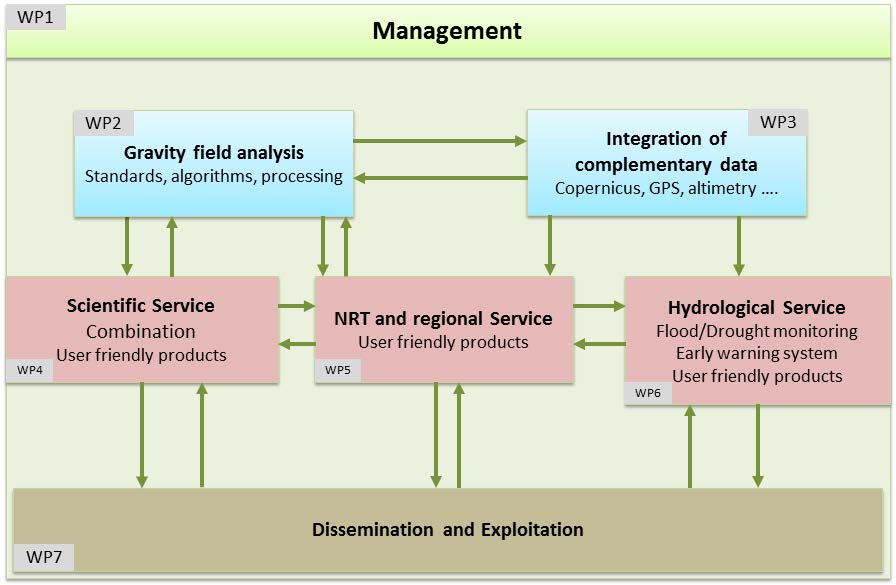EGSIEM is a three year project, funded under the European Union’s H2020-Earth Observation-2014 call for research projects and is organized around the following seven work packages:

The above five technical Work Packages and their objectives within EGSIEM are expanded upon below;
WP2: Gravity Field Analysis
Work Package 2, being led by the Graz University of Technology, will provide a critical analysis of GRACE processing standards, background models, reference frames and algorithms. It will also work on a consistent orbit parameter estimation process and the gravity model reprocessing for a time frame of two years by five gravity Analysis Centers. The last task set aside for WP2 is the establishment of a realistic GRACE-FO instrumental error behavior, to be used in GFZ´s E2E gravity data simulator to investigate the gain for hydrological applications. This can be expected from the GRACE-FO or Next Generation Gravity Missions using LRI observations.
WP3: Integration of Complementary Data
The University of Luxembourg is leading Work Package 3, which consists of the pre-processing of all necessary supplementary data which are required for the Gravity Field Analysis (as mentioned above) in WP 2, and the combination of the Gravity Data and Hydrological Models in WP 4-6. The Wp will also use loading estimates derived from GNSS station time series for the validation of the 1) combined global, 2) the near real-time and 3) the regional gravity field solutions. Lake and river levels from the Hydroweb project will be also be used, together with hydrological models, in WP 6 as well as Glacial Isostatic Adjustment (GIA) models, for separating the hydrological trend.
WP4: Scientific Service
This Work package, being led by the University of Bern, will define the necessary scientific service products, which will include Level-2 (spherical harmonics) & Level-3 (e.g. in equivalent water heights or surface mass densities on global scales) Gravity Field products. Standard data formats will be used and new formats will be defined where necessary. UBERN will combine global monthly gravity models from the individual Analysis Centers, and provide user-friendly Level-3 products. Whilst also validating the individual and combined gravity field solutions.
WP5: NRT and Regional Service
GFZ are leading WP5 which will provide near real time mass redistribution products for all areas of interest to the consortium and others regarding instrument data, background models and auxiliary data and will setup necessary interfaces to other WPs or to the GRACE Science Data System. This WP is also concerned with the provision of regional gravity field solutions with increased spatial resolution GFZ and TUG will improve current methods based on alternative representations of the gravity field (e.g. radial base functions) to derive regional mass transport solutions and will process these alternative and experimental models for the complete mission period for all areas of interest.
WP6: Hydrological Service
Work Package 6 is led by GFZ and validates the new gravity products for historical flood events by a combination of complementary observation data sets and hydrological/hydraulic modelling. The work package prepares a flood data catalogue to summarize the suite of multi-method data sets for selected extreme events. WP6 will also develop gravity-based indicators for the forecasting of extreme hydrological events with lead times of several months up to near real time. Finally it will improve the mechanisms for automatic satellite-based flood detection services within the Center for Satellite Based Crisis Information (ZKI) of DLR.
WP7: Dissemination and Exploitation
The aim of this last Work Package is to ensure that the work on EGSIEM is not only available to a narrow section of the scientific community, but to any and all who are interested in the data and products that ensue. Although the nominal lead of WP7 is the University of Bern, all members of the consortium are contributing to the dissemination and exploitation activities. Many of which you will see publicized on this website and via Facebook and Twitter.
